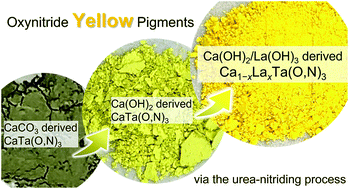Non-ammonolysis synthesis and characterisation of environmentally benign yellow pigments based on calcium–tantalum perovskite oxynitrides†
Abstract
Calcium–tantalum-based perovskite oxynitrides were synthesised as candidates for environmentally benign inorganic yellow pigments. The compounds were prepared via a urea-nitriding method, which does not involve a harmful ammonolysis process. Rapid single-phase synthesis was achieved under the optimum conditions, and only removable by-products were generated. Although the colours and bandgap energies of the obtained calcium–tantalum oxynitrides, CaTa(O,N)3, fell short of those of CaTaO2N synthesised by ammonolysis, they were made comparable by doping with La3+. Among the samples synthesised in this study, the most brilliant yellow hue was achieved with Ca0.8La0.2Ta(O,N)3, which has lightness (L*) and yellowness (b*) values comparable to those of conventional inorganic yellow pigments. In this synthetic method, harmful substances are eliminated both from the products and the synthesis process. In addition, the short heat-treatment duration enables the products to be obtained as fine powders suitable for pigment applications. Calcium–tantalum-based perovskite oxynitrides prepared by the strategy developed in this study have potential applications as environmentally benign yellow pigments.



 Please wait while we load your content...
Please wait while we load your content...